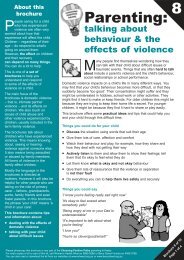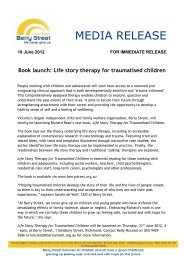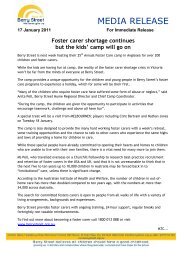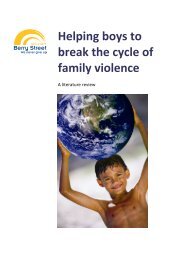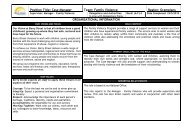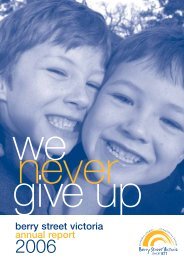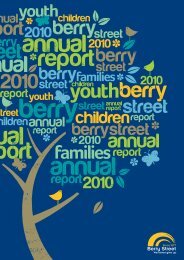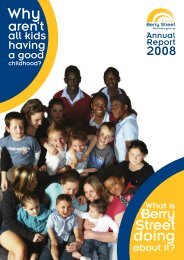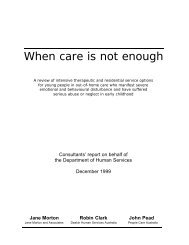Take Two - Third Evaluation Report More than Words ... - Berry Street
Take Two - Third Evaluation Report More than Words ... - Berry Street
Take Two - Third Evaluation Report More than Words ... - Berry Street
You also want an ePaper? Increase the reach of your titles
YUMPU automatically turns print PDFs into web optimized ePapers that Google loves.
Figure 33. Baseline data: Percentage of children in clinical range on each scale in TSCYC (N=90) 122<br />
Figure 34. Proportion of people listed as most important in each area in the child’s life<br />
(N=77 baseline social network grids) 126<br />
Figure 35. Representation of a 10-year-old girl’s network of relationships 127<br />
Figure 36. Representation of an 11-year-old boy’s network of relationships 127<br />
Figure 37. Representation of a 14-year-old boy’s network of relationships 128<br />
Figure 38. Representation of an 8-year-old girl’s network of relationships 130<br />
Figure 39. Percentage of each respondent type to the stakeholder survey (N=266) 134<br />
Figure 40. How would you rate the overall service received from <strong>Take</strong> <strong>Two</strong> according to the stakeholder<br />
survey (N=262) 135<br />
Figure 41. Percentage of responses to statement ‘I liked the service given by <strong>Take</strong> <strong>Two</strong>’ by type of<br />
stakeholder (N=254) 136<br />
Figure 42. Percentage of responses to statement ‘I found the people at <strong>Take</strong> <strong>Two</strong> understanding’ by type of<br />
stakeholder (N=255) 136<br />
Figure 43. Percentage of responses to statement ‘I felt included by <strong>Take</strong> <strong>Two</strong>’ by type of stakeholder<br />
(N=248) 137<br />
Figure 44. Percentage of responses to statement ‘It was easy for the child to get the service’ by type of<br />
stakeholder (N=220) 137<br />
Figure 45. Percentage of responses to statement ‘<strong>Take</strong> <strong>Two</strong> staff spoke with the child in a way they<br />
understood’ by type of stakeholder (N=220) 138<br />
Figure 46. Percentage of responses to statement ‘<strong>Take</strong> <strong>Two</strong> respected the child’s culture’ by type of<br />
stakeholder (N=216) 138<br />
Figure 47. Percentage of responses to statement ‘The child is better at handling daily life’ by type of<br />
stakeholder (N=240) 139<br />
Figure 48. Percentage of responses to statement ‘The child gets along better with family’ by type of<br />
stakeholder (N=239) 140<br />
Figure 49. Percentage of responses to statement ‘The child gets along better with friends’ by type of<br />
stakeholder (N=242) 140<br />
Figure 50. Percentage of responses to statement ‘The child is doing better at school’ by type of<br />
stakeholder (N=223) 141<br />
Figure 51. Percentage of responses to statement ‘The child is better able to cope when things go wrong’<br />
by type of stakeholder (N=242) 141<br />
xvi<br />
Frederico, Jackson, & Black (2010) “<strong>More</strong> <strong>than</strong> <strong>Words</strong>” – <strong>Take</strong> <strong>Two</strong> <strong>Third</strong> <strong>Evaluation</strong> <strong>Report</strong>, La Trobe University, Bundoora, Australia





